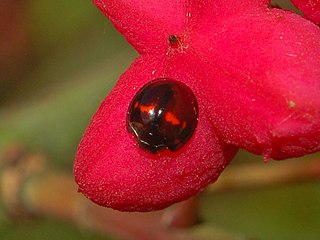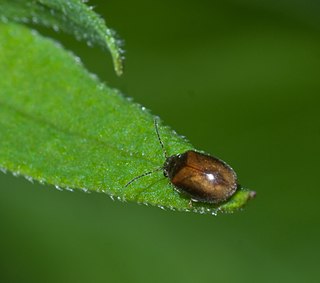
Cicindela, commonly known as common tiger beetles, are generally brightly colored and metallic beetles, often with some sort of patterning of ivory or cream-colored markings. They are most abundant and diverse in habitats very often near bodies of water with sandy or occasionally clay soils; they can be found along rivers, sea and lake shores, sand dunes, around dry lakebeds, on clay banks, or woodland paths.

Buprestis is a genus of beetles in the tribe Buprestini, the jewel beetles. As of 2011 there were 78 described species distributed across most of the world's biogeographic realms except parts of Africa and Antarctica.

Agonum is a large genus of ground beetles in the subfamily Harpalinae, tribe Platynini. They are mid-sized to smallish beetles, typically with dark metallic hues – often reddish or bronze, but sometimes black, green etc.

Altica is a large genus of flea beetles in the subfamily Galerucinae, with about 300 species, distributed nearly worldwide. The genus is best represented in the Neotropical realm, well represented in the Nearctic and Palearctic, but occurs also in the Afrotropic, Indomalaya, and Australasia. The species are similar to each other, small metallic blue-green-bronze beetles, often distinguished from each other only by the aedeagus. The species of Altica, both as larvae and as adults, are phytophagous, feeding on plant foliage of various food plant taxa, specific for each Altica species. Onagraceae and Rosaceae are the dominant host plant families for Holarctic species. The adult Altica beetles are able to jump away when approached.

Blethisa is a genus in the beetle family Carabidae. There are about nine described species in Blethisa, found in the Holarctic.

Stenolophus is a genus of beetles in the family Carabidae. There are more than 190 described species in the genus Stenolophus.

Dicerca is a genus of beetles in the family Buprestidae. It contains the following species:

Chilocorus is a genus of beetles belonging to the family Coccinellidae, subfamily Chilocorinae.

Lanelater is a genus of click beetle belonging to the family Elateridae.

Phymatodes is a genus of longhorn beetles in the family Cerambycidae. There are more than 50 described species in Phymatodes, found throughout much of the norther hemisphere.

Semanotus is a genus of beetles in the family Cerambycidae, first described by Étienne Mulsant in 1839.

Psylliodes is a large genus of flea beetles in the family Chrysomelidae. There are about 200 described species worldwide.

Contacyphon is a genus of marsh beetles in the family Scirtidae. There are over 100 described species in Contacyphon, all of which were formerly treated under the deprecated name Cyphon, which was recognized as an objectively invalid name.

Cercyon is a genus of water scavenger beetles in the family Hydrophilidae. There are at least 50 described species in Cercyon.

Systena is a genus of flea beetles in the family Chrysomelidae. There are about 90 described species, found in the New World, mostly in the Neotropics.

Byrrhus is a genus of pill beetles in the family Byrrhidae. There are at least 30 described species in Byrrhus.

Ampedus is a genus of click beetles in the family Elateridae. There are currently 461 recognized species of Ampedus beetles. It has a cosmopolitan distribution, but is found mostly in the Holarctic region, primarily in North America, Europe, and Asia. The oldest known fossil from this genus was found in Eocene Baltic amber, estimated to be from 38.0 to 33.9 million years ago.

















